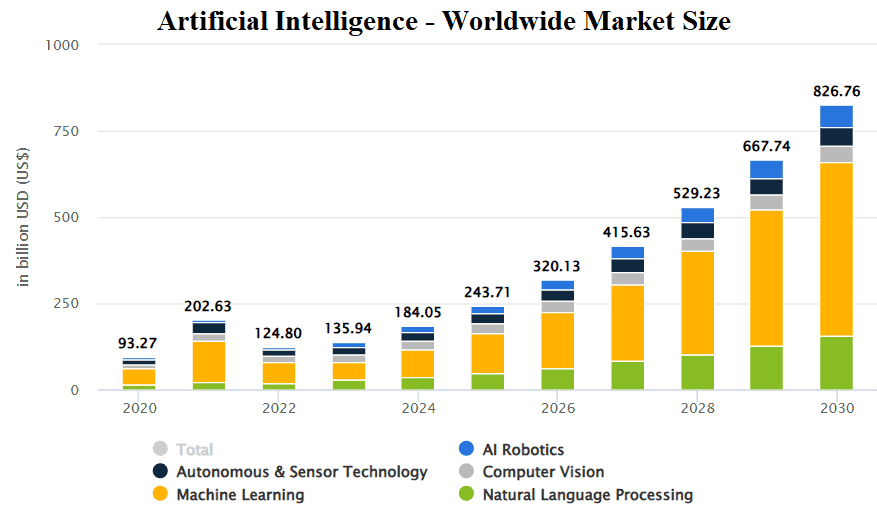
Introduction
Artificial Intelligence Statistics: Artificial Intelligence (AI) is changing the way we live and work. It is a powerful technology that helps machines think, learn, and make decisions like humans. AI is used in almost every industry, from healthcare and education to entertainment and business. Over the years, AI’s growth has been remarkable as more companies adopt improved efficiency and can solve complex problems.
In 2024, AI is making even bigger impacts. The numbers show rapid progress in AI’s role in the economy, technology, and daily life. These statistics help us understand how AI is shaping the future and creating new opportunities. Whether it’s smarter chatbots or innovative AI-powered tools, this technology is set to play a key role in tomorrow’s world.
Editor’s Choice
- The Artificial Intelligence market will grow up to USD 184 billion by 2024.
- Artificial Intelligence Statistics show that the AI market will grow at a compound annual growth rate (CAGR) of 28.46% from 2024 to 2030.
- AI is expected to contribute USD 15.7 trillion to the global economy by 2030, increasing global GDP by 26%.
- The United States will have the largest market, valued at USD 50.16 billion in 2024.
- Approximately 35% of companies have adopted AI in their operations globally.
- AI is anticipated to create 97 million new jobs by 2025, despite concerns about job displacement.
- 97% of individuals using digital devices interact with AI daily, often without realizing it.
- The global chatbot market will reach up to USD 1.25 billion by 2025.
- The facial recognition market is supposed to make around USD 5.71 billion in 2024 and USD 10.34 billion by 2030.
- Artificial Intelligence Statistics further elaborates that ChatGPT reached over 100 million users within two months of its launch, becoming one of the fastest-growing AI applications.
- AI systems consume approximately 85 to 134 terawatt-hours (TWh) of electricity annually.
- Investments in AI startups have increased sixfold since 2000, with significant growth observed in recent years.
You May Also Like To Read
General Artificial Intelligence Statistics
- As of 2024, the global AI market will be worth over USD 279 billion.
- By the end of 2026, the United States AI market may reach USD299.64 billion.
- Meanwhile, 83% of businesses see AI as a key part of their plans.
- Netflix earns USD 1 billion yearly from personalized recommendations made by AI.
- In contrast, around 48% of companies use AI to better manage big data, and 38% of healthcare providers use computers to help with diagnoses.
- Artificial Intelligence Statistics also show that organizations worldwide are expected to adopt AI at a 36.6% annual growth rate from 2024 to 2030.
- By the end of this decade, AI technology could boost revenue by over USD 15 trillion.
- AI chip sales worldwide are expected to exceed USD 80 billion in the coming years.
- By next year, nearly 100 million people will work in the AI field.
- China, the second-biggest economy globally, will see its AI industry reach USD 40.6 billion by 2026, growing at 39.1% CAGR.
- Nearly 80% of companies see AI as a key focus in their business plans.
- By 2025, 80% of retail leaders believe their businesses will use AI automation.
Artificial Intelligence Market Size Statistics By Segments

(Reference: statista.com)
- Artificial Intelligence Statistics for 2024 show that the market size of machine learning will be around USD 79.29 billion.
- The market size of other AI segments is followed by natural language processing (USD 36.42 billion), computer vision (USD 25.80 billion), autonomous & sensor technology (USD 25.51 billion), and AI robotics (USD 17.03 billion).
Furthermore, other segments market size in coming years are stated in the table below:
| Year (USD billion) | AI Robotics | Autonomous & Sensor Technology | Computer Vision | Machine Learning | Natural Language Processing |
| 2025 | 22.52 | 30.51 | 29.27 | 113.10 |
48.31 |
|
2026 |
29.16 | 35.25 | 32.57 | 159.80 |
63.35 |
|
2027 |
36.78 | 39.77 | 35.71 | 221.70 | 81.67 |
| 2028 | 44.96 | 44.07 | 38.70 | 298.70 |
102.80 |
|
2029 |
54.20 | 49.15 | 42.39 | 394.00 | 128.00 |
| 2030 | 64.35 | 55.25 | 46.96 | 503.40 |
156.80 |
AI Market Size Change Statistics By Segments
| Year (USD) | AI Robotics | Autonomous & Sensor Technology | Computer Vision | Machine Learning | Natural Language Processing |
| 2024 | 34.32% | 26.16% | 16.62% | 55.92% | 21.12% |
| 2025 | 32.26% | 19.61% | 13.48% | 42.65% | 32.65% |
| 2026 | 29.51% | 15.55% | 11.27% | 41.27% | 31.14% |
| 2027 | 26.12% | 12.80% | 9.63% | 38.73% | 28.91% |
| 2028 | 22.25% | 10.82% | 8.38% | 34.74% | 25.86% |
| 2029 | 20.54% | 11.52% | 9.53% | 31.91% | 24.52% |
| 2030 | 18.73% | 12.41% | 10.77% | 27.76% | 22.48% |
Artificial Intelligence Software Market Revenue Statistics

(Source: cdn.buttercms.com)
- As mentioned in Artificial Intelligence Statistics, the global AI software market revenue in 2023 was USD 70.94 billion, up from USD 51.27 billion in 2022.
- The AI software market is estimated to reach USD 94.41 billion by 2024 and USD 126 billion by 2025.
Artificial Intelligence Market Statistics
- Artificial Intelligence Statistics states that from 2021 and 2022, the AI market grew by 47%.
- In 2023, it increased by 38%, and in 2024, it is expected to grow by 34%.
- This steady growth is predicted to continue, with a yearly increase of at least 26% until 2025.
Generative Artificial Intelligence Market Size Statistics

(Reference: statista.com)
- As mentioned in Artificial Intelligence Statistics, the market size of generative artificial intelligence will amount to USD 36.06 billion by the end of 2024, increasing from USD 2023 to around USD 20.48 billion.
- Moreover, the estimated market size of generative AI in the next few years is followed by 2025 (USD 62.72 billion), 2026 (USD 103.50 billion), 2027 (USD 156.90 billion), 2028 (USD 215.40 billion), 2029 (USD 281.90 billion) and 2030 (USD 356.10 billion).
Global AI Revenue Comparison By Country
- Artificial Intelligence Statistics report that the market is estimated to grow to USD 50.16 billion by 2024.
- From 2024 to 2030, it is expected to grow annually by 28.3%, reaching USD 223.7 billion in 2030.
Other top four countries’ market analyses in 2024 are stated in the table below:
| Country | Market Size (USD) |
CAGR (from 2024 to 2030) |
| China | 34.20 billion | 28.61% |
| Japan | 8.12 billion | 28.48% |
| Germany | 7.85 billion | 28.41% |
| India | 6.26 billion | 28.63% |
By Region, 2024
| Region | Revenue (USD) |
CAGR (2024 to 2030) |
| Africa | 3.70 billion | 28.34% |
| Americas | 63.90 billion | 28.34% |
| Asia | 66.03 billion | 28.58% |
| Australia & Oceania | 3.74 billion | 28.52% |
|
Caribbean |
218.90 million | 28.56% |
| Central & Western Europe | 28.16 billion | 28.40% |
| Europe | 46.67 billion | 28.44% |
Artificial Intelligence Adoption Statistics By Business and Companies
- AI is widely used to make business operations more efficient and effective (56%).
- Artificial Intelligence Statistics show that it helps manage cybersecurity and prevent fraud (51%) and can also serve as a digital personal assistant (47%).
- Businesses rely on AI for managing customer relationships (46%) and inventory (40%).
- It’s also used for creating content (35%) and recommending products (33%).
- AI supports accounting, supply chain tasks (30%), hiring (26%), and understanding different audience groups (24%).
- In 2024, most employees (71%) worry about using AI at work. Nearly half (48%) feel more concerned now compared to 2023.
- AI adoption varies by group: 31% Gen Z, 37% Millennials, 28% Gen X, and 20% Boomers. It’s also used by 52% of engineers, 49% of executives, 40% of professionals, and 38% of managers.
- Artificial Intelligence Statistics stated more than 90% of top service providers use AI throughout their talent processes.
- Around one-third of workers already use AI tools in their daily tasks.
- 25% of competitive intelligence leaders use AI now, with 56% planning to start soon. Most C-suite leaders (65%) feel comfortable with AI, compared to 53% of engaged employees, 46% of managers, and 30% of disengaged employees.
You May Also Like To Read
Artificial Intelligence Usage Statistics

(Source: cdn.buttercms.com)
- In 2024, 83% of businesses say making AI part of their strategies is very important.
- Artificial Intelligence Statistics further states that about 33% of companies are already using AI, and 25% have fully integrated AI into their processes.
- Around 21% have successful AI trials and are planning to expand.
- Others include 14% who tested AI with little success and 7% who have not used AI yet but are exploring it.
Artificial Intelligence Statistics By Top Voice Assistants

(Reference: cdn.buttercms.com)
- Google Assistant is better than Siri and Cortana in terms of navigation, with a 98% accuracy rate. It is followed by Siri (86%) and Alexa (72%).
As of 2024, the share of questions answered correctly by selected digital assistants is detailed in the table below:
| Type of question | Google Assistant | Siri | Alexa |
| Information | 96% | 76% | 93% |
| Local | 93% | 89% | 85% |
| Commerce | 92% | 68% | 71% |
| Command | 86% | 93% | 69% |
Total Addressable AI Market Statistics By Scenario Analysis

(Source: statista.com)
- Artificial Intelligence Statistics also show that in 2024, the optimistic scenario had the largest market size, at USD 2.55 trillion.
- Followed by a moderate scenario (USD 2.15 trillion) and a conservative scenario (USD 1.84 trillion).
In coming years, the estimated market size of the overall addressable AI market by other scenarios:
| Year | Conservative | Moderate | Optimistic |
| (USD trillion) | |||
| 2025 | 3.22 | 3.66 | 4.31 |
| 2026 | 5.24 | 5.78 | 6.89 |
| 2027 | 7.52 | 8.22 | 9.82 |
| 2028 | 9.58 | 10.41 | 12.45 |
| 2029 | 11.12 | 12.06 | 14.42 |
| 2030 | 12.14 | 13.15 | 15.72 |
Impact of Artificial Intelligence Market on GDP
| Year | Conservative Scenario |
Moderate Scenario |
Optimistic Scenario |
| 2024 | 1.76% | 2.06% | 2.44% |
| 2025 | 2.92% | 3.29% | 3.92% |
| 2026 | 4.53% | 4.99% | 5.96% |
| 2027 | 6.20% | 6.78% | 8.09% |
| 2028 | 7.53% | 8.19% | 9.78% |
| 2029 | 8.39% | 9.10% | 10.88% |
| 2030 | 8.81% | 9.54% | 11.41% |
Artificial Intelligence in Marketing, Customer Service, and Sales Statistics
- As of 2024, AI and ML are used 40% more in marketing and sales to boost revenue success.
- Using AI algorithms can boost leads significantly, increasing them by up to 50% effectively.
- Artificial Intelligence Statistics show that it boosts sales by increasing cutting call times by 60%.
- Overall, businesses save up to 60% on costs with AI.
Impact of AI on Jobs and Employment Statistics
- AI will create 12 million more jobs than it replaces.
- By 2025, 97 million AI specialists will be needed, showing high demand in the industry.
- In 2023, over 25% of startup investments in the US went to AI companies.
- IBM says 30% of IT workers use AI and automation to save time. According to eMarketer, 69% of leaders think AI will create new jobs.
Artificial Intelligence Retail Statistics

(Source: mordorintelligence.com)
- The AI in the retail market is valued at USD 9.85 billion in 2024.
- It is expected to grow rapidly and reach USD 40.49 billion by 2029, with an annual growth rate of 32.68%.
- AI spending in retail is predicted to reach USD 20.05 billion by 2026, growing 39% annually since 2019.
- 80% of retail leaders believe their companies will use AI automation by 2027.
- According to Juniper Research, machine learning investments grew by 230% from 2019 to 2023.
Artificial Intelligence Marketing and Sales Statistics
- Artificial Intelligence Statistics show that 48% of marketing leaders say AI greatly improves customer interactions.
- Meanwhile, 51% of eCommerce businesses use AI for smoother customer experiences.
- Most B2B marketers (about 64%) see AI as an important part of their strategy.
Artificial Intelligence Technology Statistics By Industry, 2035
| Industry | Baseline
(USD ) |
Additional AI Contribution
(USD) |
| Manufacturing | 8.4 trillion | 3.78 trillion |
| Professional Services | 7.47 trillion | 1.85 trillion |
| Wholesale and Retail | 6.18 trillion | 2.23 trillion |
| Public Services | 3.99 trillion | 939 billion |
| Information and Communication | 3.72 trillion | 951 billion |
| Financial Services | 3.42 trillion | 1.15 trillion |
| Construction | 2.76 trillion | 520 billion |
| Healthcare | 2.26 trillion | 461 billion |
| Transportation and Storage | 2.13 trillion | 744 billion |
| Accommodation and Food Services | 1.5 trillion | 489 billion |
| Social Services | 1.08 trillion | 216 billion |
| Education | 1.06 trillion | 109 billion |
| Utilities | 962 billion | 304 billion |
| Agriculture, Forestry, and Fishing | 554 billion | 215 billion |
| Arts, Entertainment and Recreation | 453 billion | 87 billion |
| Other Services | 535 billion | 95 billion |
You May Also Like To Read
Artificial Intelligence Tools Users Statistics
- Artificial Intelligence Statistics show that in 2023, the total number of AI tools users accounted for around 254.80 million and will reach up to 314.40 million by the end of 2024.
- Furthermore, the number of AI tool users globally is followed by 2025 (378.80 million), 2026 (451.80 million), 2027 (529.80 million), 2028 (605.90 million), 2029 (673.80 million), and 2030 (USD 729.10 million).
Artificial Intelligence Publication Statistics
| Year | Number of publications
(in million) |
| 2023 | 0.36 |
| 2024 | 0.39 |
| 2025 | 0.42 |
| 2026 | 0.45 |
| 2027 | 0.48 |
| 2028 | 0.50 |
| 2029 | 0.53 |
| 2030 | 0.56 |
AI Improving Employee Training Statistics
- Artificial Intelligence Statistics states that AI tools help create training videos 62% faster, saving around 8 days.
- The main advantage for AI video creators is faster production, with 78.8% reporting reduced time.
- Employees save 34% of their time, about 45 hours monthly, using AI video tools.
- Additionally, 42% of Learning and Development managers now use AI instead of traditional video production methods.
- L&D managers who used AI training videos saw better results, such as completion rates increasing by 57%, learning time being 60% faster, and satisfaction scores improving by 68%.
- In 2024, ChatGPT helps people work faster, boosting productivity by up to 40% through time-saving.
- Using AI systems can raise overall employee efficiency by 30%, and IT automation saves about 1.9 hours per employee each week.
Artificial Intelligence Usage Statistics in Marketing, Content Creation And SEO
- As of 2024, About 40% of companies have hired AI experts to support their marketing teams.
- An impressive 95% of businesses using AI are likely to succeed with effective marketing strategies.
- AI can boost lead generation by up to 50%, showing its strong potential.
- AI is expected to grow further in marketing, content creation, and SEO.
- Artificial Intelligence Statistics in 2024 show that businesses are most focused on using AI to create content (55%), optimize SEO data (54%), generate images (53%), produce videos (52%), and make audio (22%).
- Approximately, almost 58% of marketers plan to increase AI investments.
- AI helps 72% personalize experiences, 70% improve customer interactions, 60% assist tasks, and 16% fear job replacement.
- Marketers use AI for inspiration (45%), creating outlines (31%), drafting content (18%), and writing full content (6%).
- Marketers save three hours per content piece and 2.5 hours daily using AI tools.
- Most (85%) think generative AI will change content creation in 2024.
- However, 60% worry about bias or plagiarism harming brand reputation.
- Many businesses see better SEO (65%) and ROI (68%), with AI-generated content ranking highly (76%).
AI Usage Statistics By Consumer Sentiment
- Based on Artificial Intelligence Statistics, around 70% of consumers believe the benefits of generative AI are greater than its risks.
- About 65% of people trust businesses using modern AI technology.
- Nearly half (48%) think the generative AI market lacks proper regulation.
- Around 31% feel the current AI market regulations are adequate.
- Approximately one-third of people say AI tools have boosted their work productivity, but the impact differs by region.
- For example, countries like India (67%) and Indonesia (65%) see higher benefits, while Sweden (14%) and the US (17%) report lower effects.
- More than 60% of consumers worry about AI causing fake news, scams, and cybersecurity issues.
- Many also fear job losses (77%) and over-reliance on technology (40%), while 65% prefer using ChatGPT over search engines.
AI Impact on The Demand for Numerous Skills

- By 2024, about 72% of professionals expect AI to boost interest in new technologies and a 2% decrement.
Similarly, Artificial intelligence hurts the demand for various other skills in 2024 are detailed below:
| Skills | Increase | Decrease |
| Adaptability to change | 71% | 2% |
| Efficiency | 61% | 3% |
| Problem-Solving | 56% | 4% |
| Creativity | 53% | 6% |
| Proactivity | 52% | 4% |
| Communication skills | 52% | 6% |
| Resilience | 49% | 4% |
| Emotional Intelligence | 48% | 7% |
| Logic | 48% | 7% |
| Active Listening | 48% | 7% |
| Attention to detail | 45% | 6% |
| Negotiation skills | 44% | 4% |
| Pragmatism | 40% | 4% |
| Enthusiasm | 39% | 4% |
| Memory for facts | 27% | 19% |
Conclusion
Artificial intelligence is a recent age that is changing enormously based on the way we live and work, making tasks faster and smarter. AI is helping businesses to grow, improving healthcare, and even making everyday activities easier. However, users should be careful and use AI responsibly to ensure it benefits everyone.
As AI continues to grow, it’s clear that it will play an even bigger role in shaping our future. By using it wisely, we can create a better and more efficient world for all.
What are examples of AI in daily life?
AI helps in daily life with voice assistants, online shopping, smart home devices, social media, navigation, and personalised recommendations.
AI works by learning patterns from data, making decisions, and solving problems like humans do.
Can AI replace human jobs?
AI can replace some jobs by automating tasks, but humans remain vital for creativity and judgment.
Many industries use AI, like healthcare, finance, education, entertainment, retail, manufacturing, transportation, and agriculture.
Learn AI by studying online courses, practising coding, exploring algorithms, and building small AI projects.

Saisuman Revankar
Saisuman is a talented content writer with a keen interest in mobile tech, new gadgets, law, and science. She writes articles for websites and newsletters, conducting thorough research for medical professionals. Fluent in five languages, her love for reading and languages led her to a writing career.
With a Master’s in Business Administration focusing on Human Resources, Saisuman has worked in HR and with a French international company. In her free time, she enjoys traveling and singing classical songs.
At Coolest Gadgets, Saisuman reviews gadgets and analyzes their statistics, making complex information easy for readers to understand.











